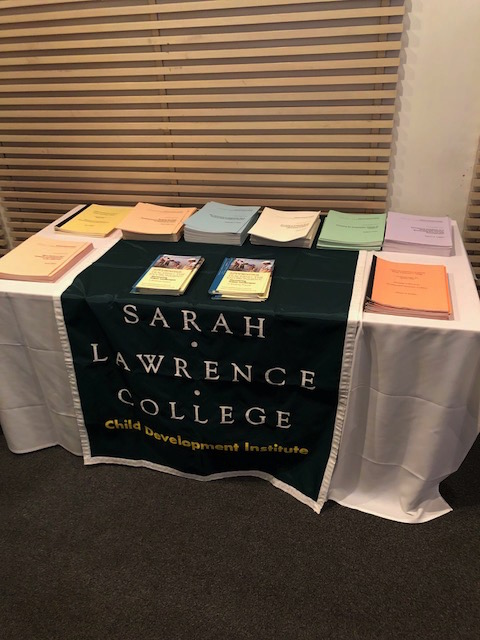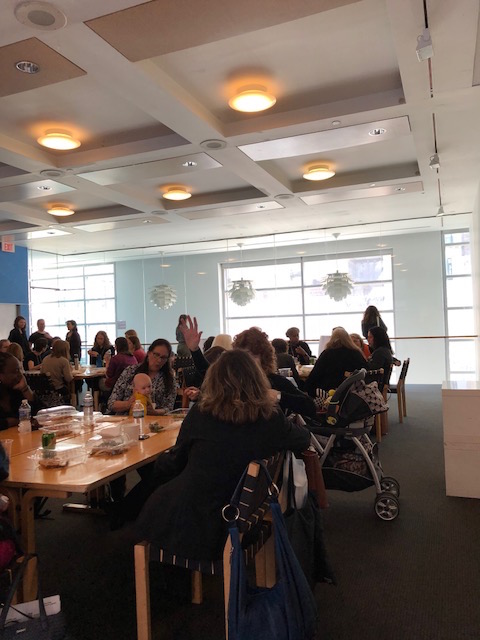A field report by Peter K. Defenderfer
I attended a few panels at the Early Child Development Symposium at Scandinavia House, where I already work, held in conjunction with Sarah Lawrence college. The event’s full title is actually quite long, and includes a clause at the end about expanding the Nordic-American dialogue on early education. So, in the foundation’s terms this was not a “rental” event for them, but the panels were not exclusively reflective of issues centered in the Nordic countries either. One speaker with many perspectives was from northern Italy, another Danish and Turkish, and some American. It was general in international connections, about migrants, identity, pyschology and their negotiating in practical and positive teaching.

I gathered a lean in almost all the panels (roughly three or four total, in full or in part) toward practical learning, that is deconstructing essentially xenophobic biases, and toward inclusive and possibly origin-revamped image maintenance. Early in an anthropology class, where I was my first semester of college, you might quickly learn the terms (and difference between) ‘cosmogony’ and ‘cosmology.’ When studying a culture as we could parallel in any classroom setting a cosmogony or origin story would seem constant and important. Just as say the Aborigines traditionally represented almost all abstract facets of their life through a concept called the Dreaming, which they represent in art, it might seem unfair that other cultures are grazed with narratives that are not as vibrant or affirming. The presentation of origin stories and heartened images in multicultural settings via somewhat autonomous and probably always equivocating teachers seems to be acknowledged as a point of constant debate.
And somewhat collusive with diffusing threadbare and inconsistent narratives, the stated goals of the Sarah Lawrence Early Childhood Development Center—long name, but from what I can tell it’s basically a preschool and kindergarten school with an research branch—have much to do with practical learning; and this emerged as one of the encompassing if not satisfactory lights at the end of the tunnel to most of what the panelists discussed. The mission statement near the top of the Sarah Lawrence center’s website for example readily dishes anecdotes of having children make applesauce in an age when they might otherwise be adept with a microwave, etc. But aside from flippant examples, the question of the right level, and nature, of stimulation and identity presentation feels compelling.

There were two Sarah Lawrence students (undergraduates, I guess) helping with the event and also a table outside the main auditorium covered in academic papers from the center’s past researchers or teachers, bound in soft color covers and often with a sub-labeling “occasional paper series.” Not all these papers were terribly recent either. They were freshly printed for this event but some were from 1999 or 2000. To make a few notes about attendance and composure, it was mostly all women in the auditorium (audience varying slightly panel to panel) and this was even acknowledged at one point, one of the women said something like “we’re all women here” in a tone and impression I guess would call maternal since other comments were made about mothers’ instincts for these issues, but “thank you to any men who are here.” Aside from that there was a chatty, inclusive and rarely slightly feisty tone to the audience comments. With regard to the two Sarah Lawrence students assisting, I did catch one memorable exchange between them and one of the Scandinavia House building managers. The in-house restaurant had made generous and upscale box lunches for the entire event, including vegetarian options, but the two Sarah Lawrence students claimed there was hardly anything in these for them, and asked if their outside lunches could be paid for because one of them was vegan and the other was gluten-free. The building manager with lightly tugged patience said the restaurant would be able to handle it. I needed to include this because I don’t know how it is either relevant or irrelevant, and Joan Didion wouldn’t be remiss to include it.

One of the consistent themes I certainly connected with was the role of pathogenic environmental factors, or harm, overstimulation and chaos, be them either racially-originated or from circumstantial direct and indirect human factors. This seemed essentially like one of the points that branched to multiple subjects throughout the symposium, such as migrant and refugee identities and media coverage, and government intervention. For example some time was spent on the role of media in refugee coverage. Gary Evans, an ‘environmental and developmental psychologist’ from Cornell, was talking about human interest stories as portraying refugees as in need of support, which is claimed as a turnoff to “western” people, but moreover I had the impression of a confluence of both image and identity maintenance with domestic environmental factors as incredibly predictive and affecting of children, or on people any of age for that matter.
One way to state the connection it seems to me is they are both curated, ‘soft’ factors in way—not inherent, and not a specific teaching instruction that could be theorized about in an either successful or unsuccessful gauge. Evans also mentioned IQ tests (setting aside the problems with that) as less predictive of grades than pathogenic environmental factors. The question of what is an inherent trait or temperament practically feels like it could be connected to direct teaching styles, or rather intended learning outcomes, while the effect of implied outcomes and environmental impositions that are not intentional in the same way (dysfunctional family members, stimulation breaching to chaos and anxiety) mount a second, comparably invisible force which holds much to bear on productivity.
Similar to my idea of implied image and environmental factors as invisible, Evans from Cornell commented on the role of “involuntary attention” as integral to motivation for voluntary attention or rather intentionally instructed tasks. The image on the involuntary attention slide was a typical fountain the plaza of some building. Evans suggested that this didn’t require the same kind of attention as an instructed task, but a child’s ability or freedom to engage with it, as an environmental factor but one that isn’t overbearing, was facilitative of them being able to tackle an intended task more at will, or less emerging from a place of clutter.
This stretch of that panel also allowed them to reemphasize motor skills as the obvious and crucial way we learn and become familiar with the world. As tooling with objects around the house (provided they are safe) is substantiating, so too we might gather is the freedom to loosely focus on a fountain, or whatever else is innocently present in urban or natural settings.
And with regard to deconstructing these other, human-implied factors, it seems to me to reach the core concerns of the Information Science field: Intersectionality, design, and also I would say a crucial and structural address of the question “what is productivity?” or “what is creativity?” Along with certain design approaches, a reasonably abstract answer to that starts to feel as predictive and perhaps in a better and more open way than unattended implications from existent axises people may just incline to rely on.
